- Clan Gregor
-
Clan Gregor Crest badge 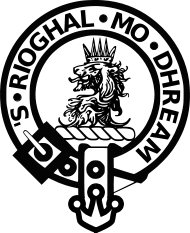
Crest: a lion's head erased Proper, crowned with an antique crown Or. Motto: 'S RIOGHAL MO DHREAM Profile Region Highland District Argyll Plant badge Scots Pine Gaelic name Mac Griogair Chief

Sir Malcolm MacGregor of MacGregor The 7th baronet of Lanrick and Balquhidder Gaelic title An t-Ailpeanach Seat Irvine House.[1] Allied clans Clan Grant Rival clans Clan Campbell
Clan MacLaren
Clan Colquhoun
Clan DrummondClan Gregor, Clan McGregor, Clan MacGregor or Clan M'Gregor is a Highland Scottish clan. It is the most senior clan of Siol Alpin, translated as (Seed of Alpin) referring to King Kenneth I, descending from the ancient Kings of the Picts and Dál Riata. Outlawed for nearly two hundred years after a long power struggle with the Clan Campbell, the Clan Gregor claims descent from Constantin and wife and cousin Malvina, first son of Doungallas and wife Spontana (daughter of a High King of Ireland) and grandson of Giric, the third son of Alpín mac Echdach, the father of Kenneth MacAlpin, the first King of Scotland, a descent which is proclaimed in the motto, 'S Rioghal Mo Dhream, translated as Royal is my Race.[2]
Contents
History
Origins
The surname MacGregor is an Anglicisation of the Gaelic Mac Griogair meaning "son of Griogar". The personal name Griogar is a Gaelic form of the personal name Gregory.[3]
The Clan Gregor is believed to have originated in Scotland during the 9th century. The MacGregors suggest that they take their name from Gregor (derived from the Latin 'Gregorius' and the Late-Greek 'Gregorios' which means "alert, watchful, or vigilant"). Gregor is identified as a son of the Scottish king Alpin II Mac Eochaidh and younger brother of Kenneth MacAlpin, the king who first united Scotland in A.D. 843. Alpin II was the son of Eochaidh VI 'the Poisonous,' High King of Scots, by his marriage to his cousin, the Pictish Princess Royal, and thus had claims to the Scottish and Pictish thrones.
Alpin was defeated and allegedly beheaded in his attempt to gain the Pictish throne. His son, Kenneth, was successful, taking advantage of Viking harassment of the Picts from the east. While there is no surviving concrete record of a younger 'Prince Gregor', the Gregg Family website claims that an ancient Latin record of the Alpinian family mentions a Gregor as a commander in the army of Kenneth Mac Alpin. Kenneth had a least one other known brother, Donald, who succeeded him as king of Scots. Unfortunately, most of the early public records of Scotland were destroyed by order of the English King Edward Plantagenet, during his occupation of Scotland at the end of the 13th century.
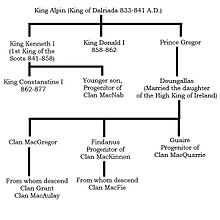 The Clan Gregor connection to King Alpin of Dál Riata
The Clan Gregor connection to King Alpin of Dál Riata
 A Victorian era, romanticised depiction of a member of the clan by R. R. McIan, from The Clans of the Scottish Highlands, published in 1845.
A Victorian era, romanticised depiction of a member of the clan by R. R. McIan, from The Clans of the Scottish Highlands, published in 1845.
It was not unusual for the Mac Alpin kings to give Latin or Scandinavian names to their sons. Typical examples are Constantine, named after the famous Roman Emperor, and Indulf, named after a Viking leader. Gregor would probably have been named after the famous Pope Gregory 'the Great' (Gregorius).[original research?]
On the other hand, Dr William Skene found a rare Medieaval Gaelic manuscript in the library of the Faculty of Advocates in Edinburgh, which traces the male line of the Mac Gregor chiefs to King Ferchar II 'the Tall', a 7th-century Scottish king of Dalriada, this would make the Mac Gregor chiefs a branch of the Cinel Labhran - the Labhran line of the original Scottish royal house, as opposed to the Cinel Gabran (King Alpin's family). Both families are male-line branches of the same Celtic royal house. If Skene's doument is correct then the present Chief's ancestor would have been a cousin (or son) of King MacBeth, and a member of his extended family. Recent research by Gerald Mckinnon, clan sennachie of Clan Fionguin (Mackinnon) has revealed a tombstone found in the royal cemetry on the holy island of Iona by the Royal Commission for Ancient and Historical Monuments of Scotland. This tombstone lists at least five Mackinnon chiefs buried there and exactly corresponds with the Mackinnon pedigree given in Dr. Skene's Gaelic manuscript. This discovery appears to confirm the descent of the Mackinnon, MacGregor and Macquarrie chiefs from Prince Ferchar Og, a younger son or grandson of King Ferchar II "Fada". Gerald Mckinnon's research further suggests that the chiefs of these three clans may even be descended from King MacBeth himself[4].
Latin charter records from the Registry of St. Andrew's Priory dating from the early 12th century record "Cormac filli Macbeath" as a charter witness about the year 1100-07[5]. Jacqueli Finley claims that MacBeth left young sons at the time of his death from mortal wounds sustained at the Battle of Lumphanan, 1057. Under Celtic Brehon Law, these princes were too young to take the Scottish throne,and were passed over in favour of their cousin, Lulach, who was then in his 30s. Lulach was crowned and enthroned at Scone (earliest surviving records of a Scottish coronation), but was killed six/seven months later by "the Saxon invaders" who placed Mael-Colum "Caenmor" on the Scottish throne (Malcolm III)[6]. Gerald suggests that Mac Beth's sons may have fled to Ulster in Ireland, where they were educated and at least one entered the Celtic church, later returning to Scotland under the protection of the Church. At least one of these sons may have married - Celtic canon permitted the marriage of priests - and the chiefs of at least three clans may be descended from Cormac, Bishop of Dunkeld, grandson, or great-grandson of MacBeth[7]. If Gerald Mckinnon's research is accurate then the traditional Alpinian descent of the MacGregor chiefs is discredited - at least in the male line, though the MacGregor chiefs are still descended from the Scots kings via King MacBeth or one of his cousins. Furthermore, surviving evidence suggests that MacBeth's mother was a MacAlpin princess, possibly the daughter of King Cinnaedh (Kenneth) II (reigned 971-995), so his descendants could then claim to represent King Alpin in the female line, since Jacqueli Finley claims that King Alpin's family became extinct in the male line at the death of King Mael-colm II in 1034[8].
The Y-chromosomal data supports the Dalriadic Scottish royal claim as the hierarchical family Y-DNA is consistent with that of the other clans claiming similar descent.[citation needed] The data supports descent from the Dalriadic Scottish kings, ancestors of the kings of united Scotland, but is not yet clear as to which branch or Cinel the Mac Gregor chiefs descend from. Further DNA research and analysis will eventually establish whether the Mac Gregors are descended from King Alpin's line (Cinel Gabran), or King MacBeth's line (Cinel Labhran).[original research?] Alternatively, historians[which?] have suggested the clan descends from a Pictish king Griogair, son of Dungal, who is said[by whom?] to have been a co-ruler of Alba, an area of north central Scotland, between AD 879 and 889. However The Y-DNA data does not support this second contention.[9][10]
Wars of Scottish Independence
By tradition in the 14th century during the Wars of Scottish Independence the Clan Gregor fought at the Battle of Bannockburn under chief Malcolm MacGregor. However most historians agree that the first certain Chief was Gregor "of the Golden Bridles." Gregor's son, Iain Camm ("of the One-Eye") succeeded as the second Chief sometime prior to 1390.
The MacGregors suffered a reversal of fortune when the Scottish king, Robert the Bruce, granted the barony of Loch Awe, which included much of the MacGregor lands, to the chief of Clan Campbell. The Campbells ejected the unfortunate MacGregors from these lands, forcing them to retire deeper into their lands until they were largely restricted to Glenstrae.[1] The MacGregors fought the Campbells for decades and were eventually dispossessed of their lands. Reduced to the status of outlaws, they rustled cattle and poached deer to survive. They became so proficient at these endeavours other clans would pay them not to steal their cattle as they exhausted other means of stopping them.
The taking of Castle Grant in the 14th century; Originally a Clan Comyn stronghold, Clan Grant traditions tell us that the castle was taken from the Comyns by a combined force of the Grants and MacGregors. The Clan Grant and Clan Gregor stormed the castle and in the process slew the Comyn Chief – and kept the Chief's skull as a trophy of this victory. The skull of the Comyn was taken as a macabre trophy and was kept in Castle Grant and became an heirloom of the Clan Grant. (In the late Lord Strathspey's book on the Clan, he mentions that the top of the cranium was hinged, and that he saw documents kept in it.) Clan tradition predicts grave things if the skull ever leaves the hands of the family – prophesying that the Clan would lose its lands in Strathspey.
16th century and clan conflicts
Iain of Glenstrae died in 1519 with no direct heirs. This plunged the Clan Gregor into disarray as the powerful Campbells meddled with succession and asserted claim to the last remaining MacGregor lands. In 1560, the Campbells dispossessed Gregor Roy MacGregor, who waged war against the Campbells for ten years before being captured and killed. His son, Alistair, claimed the MacGregor chiefship but was utterly unable to stem the tide of persecution which was to be fate of the "Children of the Mist."
Argyle and his Clan Campbell henchmen were given the task of hunting down the MacGregors. About sixty of the clan made a brave stand at Bentoik against a party of two-hundred chosen men belonging to the Clan Cameron, Clan MacNab, and Clan Ronald, under command of Robert Campbell, son of the Laird of Glen Orchy. In this battle, Duncan Aberach, one of the Chieftains of the Clan Gregor, his son Duncan, and seven other MacGregors were killed. But although they made a brave resistance, and killed many of their pursuers, the MacGregors, after many skirmishes and great losses, were at last overcome.
During the Anglo-Scottish Wars the Clan Gregor fought against the English at the Battle of Pinkie Cleugh 1547.
In 1558 a deadly feud took place between the Clan MacLaren and the Clan Gregor when the MacGregors were accused of killing 18 MacLarens men along with their whole families and taking possession of their farms. This incident was not investigated until 1604 when the MacGregors were on trial for slaughtering many men of the Clan Colquhoun. However the MacGregors were cleared of doing anything against the Clan MacLaren.
In 1589 Patrick, 3rd Lord Drummond, of Clan Drummond, appointed his deputy kinsmen, John Drummond of Drummond-Ernoch, Royal Forester of Glenartney. It was in this post that he cut off the ears of MacGregors he had caught poaching. In revenge the MacGregors attacked Drummond and cut off his head. They then proceeded to John's sisters residence, burst in, and demanded bread and cheese. The MacGregors then unwrapped John's head and crammed its mouth full. However soon afterwards a Major Stewart hunted down the MacGregors and hanged them.[11]
17th century and clan conflicts
The Battle of Glen Fruin took place in 1603 where the MacGregors were victorious, defeating five hundred Clan Colquhoun men, three hundred of whom were on horseback, by four hundred MacGregor men at Glen Fruin. Over two hundred of the Colquhoun men were lost when the MacGregors, who had split into two parties, attacked from front and rear and forced the horsemen onto the soft ground of the Moss of Auchingaich. It meant the proscription of the Clan Gregor. It wasn’t until the 18th century that the enmity between the clans was laid to rest when, at Glen Fruin on the site of the massacre, the chiefs of the Clan Gregor and Colquhoun met and shook hands.
The MacGregors were formally banished in 1603 by King James VI who made it a capital offence to bear the MacGregor name. From this period comes the Clan Gregor's most famous historical figure, Rob Roy.
The dispossessed MacGregors rustled cattle and poached deer to survive. When John Drummond, the king’s forester, was murdered after hanging MacGregors for poaching, the chief of the Clan Gregor, Alistair of Glen Strae was condemned by the Privy Council. In April 1603, King James VI issued an edict proclaiming the name of MacGregor ‘altogidder abolisheed’, meaning that those who bore the name must renounce it or suffer death.
Alistair MacGregor of Glen Strae was then captured, having sought protection from the Chief of the Campbells to go to London to beg clemence from James the VI, who had recently claimed the English throne. The Campbells gave him safe passage to the borders, but arranged in advance for soldiers to capture him on the English side, and return him to Edinburgh to stand trial. He, along with eleven of his chieftains, was hanged at Edinburgh’s Mercat Cross, or, alternatively in the Edinburgh Tollbooth, the site of which is now marked by the Heart of Midlothian. He was hung one ell higher than his relatives, to distinguish his rank.[12] in January 1604. Clan Gregor was scattered, many taking other names, such as Murray, King, or Grant. They were hunted like animals, flushed out of the heather by bloodhounds. Persecution of the MacGregors continued until 1774 when they were permitted to be reestablished.[13]
An Act of the Scottish Parliament from 1617 stated[14] (translated into modern English):
“ It was ordained that the name of MacGregor should be abolished and that the whole persons of that name should renounce their name and take some other name and that they nor none of their name and that they nor none of their posterity should call themselves Gregor or MacGregor under pain of death .... that any person or persons of the said clan who has already renounced their names or hereafter shall renounce their names or if any of their children or posterity shall at any time hereafter assume or take to themselves the name of Gregor or MacGregor .... that every such person or persons assuming or taking to themselves the said name .... shall incurr the pain of death which pain shall be executed upon them without favour. ” The Clan MacThomas spent much of their time breeding cattle and fighting off those who tried to rustle them. One of these incidents in 1606 is remembered as the Battle of Cairnwell. A force of around 200 men from the Clan Gregor and some Catarans made off with around 2,700 of the MacThomases cattle. The MacThomases eventually caught up with their enemies and defeated them but not before they had butchered most of the MacThomases cattle out of pure spite. This caused much financial damage to the MacThomases with some of the clansmen being completely ruined.[15]
The Earl of Glencairn was in Rannoch in 1653 looking for support for Charles II. He raised the Clan Gregor from the Isle of Rannoch. He would have no difficulty recruiting them because one of their opponents was the Earl of Argyll, a Campbell, one of their hereditary enemies. Alexander, the 12th chief of the Clan Robertson led his men from Fea Corrie. Both forces met above Annat and marched up the old path to Loch Garry. History informs us that the leaders quarrelled so much amongst themselves that General George Monck, an English Parliamentarian, had little difficulty in winning the ensuing Battle of Dalnaspidal.[16]
18th century and Jacobite uprisings
In the 18th century during the early Jacobite Uprisings men from the Clan Gregor fought at the Battle of Glen Shiel in 1719 led by Robert Roy MacGregor who was wounded.
During the 1745 to 1746 uprising some of the Clan Gregor who were under the Duke of Perth fought as Jacobites at the Battle of Prestonpans in 1715 and the Battle of Culloden in 1746. Most of the MacGregor fighting men missed Culloden as they were with their Chief, Gregor Ghlun Dubh (Black Knee) in Sutherland tracking the Hanoverian troops there. Persecution of the MacGregors did not end until 1774.
Clan profile
Crest badge
The crest badge suitable for members of Clan Gregor to wear consists of the chief's heraldic crest and slogan. The chief's crest is: a lion's head erased Proper, crowned with an antique crown Or. The chief's slogan within the crest badge is 'S RIOGHAL MO DHREAM, which translates from Scottish Gaelic as "my blood is royal".[17]
Plant badge
The clan badge or plant badge of Clan Gregor is Scots Pine.[18]
Chief
The current chief of Clan Gregor is Sir Malcolm Gregor Charles Mac Gregor of Mac Gregor, 7th BT, of Lanrick and Balquhidder, 24th Chief of Clan Gregor.[19] His Gaelic designation is An t-Ailpeanach,[20] a name which bears testimony to the clan's traditional descent from Siol Alpin. Full chief list.
Signet and Seal in Iowa
Descendants of Rob Roy MacGregor settled around McGregor, Iowa, and in 1849 it was reported that the original MacGregor seal and signet was owned by Alex McGregor of Iowa. The Scottish Gaelic clan seal was inscribed, "Triogal Ma Dh'ream/ Een dhn bait spair nocht", which was interpreted as "I am of royal descent/ Slay and spare not". The signet was a bloodstone from Loch Lomond, and was sketched by William Williams.[21]
Tartan
Many tartans are associated with the name MacGregor. However, only the following are recognised as "clan tartans" by the current chief of Clan Gregor :[22]
Tartan image Notes 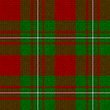
MacGregor Red and Green. A specimen of this tartan appears in the Cockburn Collection, dating from about 1810–1820, now in the Mitchell library in Glasgow. It is one of the tartans labelled in Cockburn's handwriting in 1815. It is titled as MacGregor Murray Tartan by Wilson in the Key pattern book of 1819. James Logan titled it simply as MacGregor in 1831.[23][24] 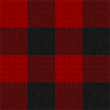
MacGregor Red and Black, also known as Rob Roy Macgregor. This is one the most primitive setts of tartan. According to tartan scholar Donald C. Stewart, it is probably the oldest "MacGregor" tartan, however it was only adopted by MacGregors at a relatively late date.[25] A specimen of this tartan exists in the collection of the Highland Society of London. This piece is signed by, and bears the Seal of Arms of Sir John MacGregor Murray of MacGregor. This and other specimens of tartan kept in the collection were collected during 1815–1816, and are now kept in the Museum of Scotland, in Edinburgh.[26] The clan chief states that any MacGregor may wear this tartan.[24] 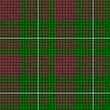
MacGregor of Cardney. This is a quite modern tartan, dating from about 1920. It has sometimes been called a hunting tartan. The current clan chief states that this tartan should only be worn by the Cardney MacGregors.[24] 
MacGregor of Glengyle, also known as MacGregor of Deeside. A specimen of this tartan dates from about 1750.[27] The clan chief states that the Glengyle branch of the clan, or MacGregors from Deeside, are entitled to wear this tartan.[24] 
MacGregor Green.[28] This is a dance tartan. The chief has approved this tartan only for Highland dancers who compete, or who have competed in competitions at Highland games. The chief states that MacGregors who are not highland dancers should not wear this tartan.[24] Septs
The following table lists clan names and sept names recognised by the Clan Gregor Society. The society states that people who bear the following surnames, or who descend from a woman with one of the following surnames, is eligible for membership. The prefixes M', Mc and Mac are considered interchangeable, and other spelling variations are also omitted from this list.[29]
Alpin Fletcher [note 1] Greer Gregg Gragg Gregor Gregorson Gregory Gregson Greig Grewer Grier Grierson [note 2] Grigg(s) Grigor Gruer Hubberd King Lawrence MacAdam [note 3] Macaldowie MacAlpin Macara Macaree MacChoiter McGehee MacConachie MacCrowther MacEan MacEwin MacGregor MacGrigor MacGrowther MacGruder Macilduy MacLeister MacLiver MacNee MacNeice MacNeish MacNie MacPeter(s) MacPetrie Magruder Malloch Neish Patullo/Pittillow Peter(s) [note 4] Petrie Roy The following names are documented aliases of MacGregor from the proscription. Membership is available for individuals who can show evidence of descent or a family tradition of MacGregor connection.[29]
Bain Bowie Dunn Leckie Stevenson Beachley Coleman Lakie Lockie White Black Comrie Landless Mor Willox Bowers Dochart Lawrence Skinner The following names are traditional aliases of MacGregor with little documented evidence. Membership is available for individuals who can show evidence of descent or a family tradition of MacGregor connection.[29]
Argyl Crowther Guiness MacGrew Shankland Arrowsmith Denison Kirkwood Macnocaird Stringer Begland Docherty Leishman Macnucator Tainsh Bowmaker Dorward MacAndrew Nelson Telfer Brewer Dowie MacAngus Neilson Telford Caird Fisher MacCanish Nucator Tossach Callander Gair MacGeach Orr Walker Clark Goodsir Macgehee Paterson Weliver Craigdallie Grayson Macghee Peat Crerar Gudger MacGill Peterson The following names are other clan names that are known to have been used by the MacGregors. People with the names from this list are properly the domain of other Clan and Family societies, however the MacGregor clan welcomes enquiries from persons bearing these names who can show their descent from a MacGregor who adopted the name as an alias.[29]
Balfour Ferguson Livingston MacInnes Murray Buchannan Gordon MacAlastair MacNeil Ramsay Campbell Graham MacDonald MacLaren Robertson Cunningham Grant MacDougal MacNicol Sinclair Douglas Hay MacEwan MacPherson Stewart Drummond Johnson MacFarlane MacWilliams Stirling Erskine Johnston MacIan Menzies Wilson See also
- Siol Alpin, clans traditionally thought to descend from Alpin.
- Battle of Glen Fruin, the famous battle with Clan Colquhoun.
- Robert Roy MacGregor, the historical Rob Roy.
Notes
- ^ There is also a recognised Clan Fletcher.
- ^ There is also a recognised Clan Grierson.
- ^ There is also a recognised Clan Adam.
- ^ There is also a recognised Clan Peter.
References
- ^ clanchiefs.org
- ^ "MacAlpine". http://genealogy.euweb.cz/brit/macalpine.html.
- ^ "McGregor Name Meaning and History". Ancestry.com (www.ancestry.com). http://www.ancestry.com/facts/McGregor-family-history.ashx. Retrieved 8 January 2009.
- ^ Origins of Clan Fhionghuinby Gerald Mckinnon
- ^ Early Scottish Charters Prior to A.D. 1153 collected by Sir Archibald C. Lawrie, published by James Maclehose and Sons, publishers to the University of Glasgow, 1905.
- ^ www.leesofvirginia.org/Clan_Finlay.html
- ^ Origins of Clan Fhionghuinby Gerald Mckinnon
- ^ www.leesofvirginia.org/Clan_Finlay.html
- ^ "MacGregor information from Electric Scotland". http://www.electricscotland.com/webclans/m/macgreg2.html.
- ^ "MacGregor history from ScotsClans.com". http://www.scotclans.com/clans/MacGregor/history.html.
- ^ ”The Drummonds” by Libby Urquhart. Published by Lang Syne Publishers Ltd. 1997. ISBN 185217041-7.
- ^ "www.geo.ed.ac.uk/scotgaz/features/featurefirst7856.html". http://www.scottish-places.info/features/featurefirst7856.html.
- ^ "www.scotclans.com/clans/MacGregor/history.html". http://www.scotclans.com/clans/MacGregor/history.html.
- ^ Black, George Fraser (1946) The Surnames of Scotland: their origin, meaning and history. [From the "Bulletin of the New York Public Library", 1943–46.] New York: New York Public Library
- ^ "www.electricscotland.com/webclans/m/macthom2.html". http://www.electricscotland.com/webclans/m/macthom2.html.
- ^ "www.visitdunkeld.com/clan-robertson-rannoch.htm". http://www.visitdunkeld.com/clan-robertson-rannoch.htm.
- ^ Way of Plean, George; Squire, Romilly (2000). Clans & Tartans. Glasgow: HarperCollins. p. 190. ISBN 0-00-472501 8.
- ^ Adam, Frank; Innes of Learney, Thomas (1970). The Clans, Septs & Regiments of the Scottish Highlands (8th edition ed.). Edinburgh: Johnston and Bacon. pp. 541–543.
- ^ "Mac Gregor of Mac Gregor, Chief of Clan Gregor". Burke's Peerage and Gentry (www.burkes-peerage.net). http://www.burkes-peerage.net/familyhomepage.aspx?FID=0&FN=MACGREGOROFMACGREGOR. Retrieved 18 September 2007.
- ^ Adam, Frank; Innes of Learney, Thomas (1970). The Clans, Septs & Regiments of the Scottish Highlands (8th edition ed.). Edinburgh: Johnston and Bacon. pp. 539–540.
- ^ William Williams (1920) Major William Williams' Journal of a Trip to Iowa in 1849. Annals of Iowa 7(4).
- ^ "The Clan Gregor Tartans". Clan Gregor Society (www.clangregor.org). http://www.clangregor.org/tartan.htm. Retrieved 8 January 2009.
- ^ "MacGregor WR1526". Scottish Tartans World Register (www.scottish-tartans-world-register.com). http://www.scottish-tartans-world-register.com/tartan.aspx?record=1526. Retrieved 8 January 2009.
- ^ a b c d e MacGregor of MacGregor, Malcolm. "Our Clan Tartans, Part Two". Clan Gregor Society (www.clangregor.org). http://www.clangregor.org/article-ourtartans2.html. Retrieved 8 January 2009.
- ^ Stewart, Donald C. (1974). The Setts of the Scottish Tartans, with descriptive and historical notes (8th edition ed.). London: Shepheard-Walwyn. pp. 75–76. ISBN 0 85603 011 9.
- ^ "Rob Roy Macgregor WR1504". Scottish Tartans World Register (www.scottish-tartans-world-register.com). http://www.scottish-tartans-world-register.com/tartan.aspx?record=1504. Retrieved 8 January 2009.
- ^ "MacGregor WR450". Scottish Tartans World Register (www.scottish-tartans-world-register.com). http://www.scottish-tartans-world-register.com/tartan.aspx?record=450. Retrieved 8 January 2009.
- ^ "MacGregor Green WR1577". Scottish Tartans World Register (www.scottish-tartans-world-register.com). http://www.scottish-tartans-world-register.com/tartan.aspx?record=1577. Retrieved 8 January 2009.
- ^ a b c d "Clan Gregor Society Sept/Family Names". Clan Gregor Society (www.clangregor.org). http://www.clangregor.org/macgregor/septs.html. Retrieved 8 January 2009.
External links
Scottish clans Clans with chiefs Agnew · Anstruther · Arbuthnott · Arthur · Bannerman · Barclay · Borthwick · Boyd · Boyle · Brodie · Broun · Bruce · Buchan · Burnett · Cameron · Campbell · Carmichael · Carnegie · Cathcart · Charteris · Chattan · Chisholm · Cochrane · Colquhoun · Colville · Cranstoun · Crichton · Cumming · Darroch · Davidson · Dewar · Drummond · Dunbar · Dundas · Durie · Elliot · Elphinstone · Erskine · Farquharson · Fergusson · Forbes · Forsyth · Fraser · Fraser of Lovat · Gayre · Gordon · Graham · Grant · Gregor · Grierson · Guthrie · Haig · Haldane · Hamilton · Hannay · Hay · Henderson · Home · Hope · Hunter · Irvine · Jardine · Johnstone · Keith · Kennedy · Kerr · Kincaid · Lamont · Leask · Lennox · Leslie · Lindsay · Lockhart · Lumsden · Lyon · MacAlister · MacBain · MacDonald · Macdonald of Clanranald · MacDonald of Keppoch · Macdonald of Sleat · MacDonell of Glengarry · MacDougall · Macdowall · MacIntyre · Mackay · Mackenzie · Mackinnon · Mackintosh · Maclachlan · Maclaine of Lochbuie · MacLaren · MacLea (Livingstone) · Maclean · MacLennan · MacLeod · MacLeod of Lewis · MacMillan · Macnab · Macnaghten · MacNeacail · MacNeil · Macpherson · MacTavish · MacThomas · Maitland · Makgill · Malcolm (MacCallum) · Mar · Marjoribanks · Matheson · Menzies · Moffat · Moncreiffe · Montgomery · Morrison · Munro · Murray · Napier · Nesbitt · Nicolson · Ogilvy · Oliphant · Primrose · Ramsay · Rattray · Riddell · Robertson · Rollo · Rose · Ross · Ruthven · Sandilands · Scott · Scrymgeour · Sempill · Shaw · Sinclair · Skene · Spens · Stirling · Strange · Stuart of Bute · Sutherland · Swinton · Trotter · Urquhart · Wallace · Wedderburn · Wemyss · Wood ·
Armigerous clans Abercromby · Abernethy · Adair · Adam · Aikenhead · Ainslie · Aiton · Allardice · Anderson · Armstrong · Arnott · Auchinleck · Baillie · Baird · Balfour · Bannatyne · Baxter · Bell · Belshes · Bethune · Beveridge · Binning · Bissett · Blackadder · Blackstock · Blair · Blane · Blyth · Boswell · Brisbane · Buchanan · Butter · Byres · Cairns · Calder · Caldwell · Callender · Campbell of Breadalbane · Campbell of Cawdor · Carruthers · Cheyne · Chalmers · Clelland · Clephane · Cockburn · Congilton · Craig · Crawford · Crosbie · Cunningham · Dalmahoy · Dalrymple · Dalzell · Dennistoun · Don · Douglas · Duncan · Dunlop · Edmonstone · Fairlie · Falconer · Fenton · Fleming · Fletcher · Forrester · Fotheringham · Fullarton · Galbraith · Galloway · Gardyne · Gartshore · Ged · Gibsone · Gladstains · Glas · Glen · Glendinning · Gray · Gunn · Haliburton · Halkerston · Halket · Hepburn · Heron · Herries · Hogg · Hopkirk · Horsburgh · Houston · Hutton · Inglis · Innes · Kelly · Kinloch · Kinnaird · Kinnear · Kinninmont · Kirkcaldy · Kirkpatrick · Laing · Lammie · Langlands · Learmonth · Little · Logan · Logie · Lundin · Lyle · MacAulay · Macbrayne · MacDuff · MacEwen · MacFarlane · Macfie · Macgillivray · MacInnes · MacIver · Mackie · MacLellan · Macquarrie · Macqueen · Macrae · Masterton · Maule · Maxton · Maxwell · McCorquodale · McCulloch · McKerrell · Meldrum · Melville · Mercer · Middleton · Moncur · Monteith · Monypenny · Mouat · Moubray · Mow · Muir · Murray of Atholl · Nairn · Nevoy · Newlands · Newton · Norvel · Ochterlony · Orrock · Paisley · Paterson · Pennycook · Pentland · Peter · Pitblado · Pitcairn · Pollock · Polwarth · Porterfield · Preston · Pringle · Purves · Rait · Ralston · Renton · Roberton · Rossie · Russell · Rutherford · Schaw · Seton · Skirving · Somerville · Spalding · Spottiswood · Stewart · Stewart of Appin · Strachan · Straiton · Strange · Sydserf · Symmers · Tailyour · Tait · Tennant · Troup · Turnbull · Tweedie · Udny · Vans · Walkinshaw · Wardlaw · Watson · Wauchope · Weir · Whitefoord · Whitelaw · Wishart · Young
Culture and society Scotland · Clan chief · Septs · Clan badge · Clan crest · Clan battles · Tartan · Bagpipes · Clearances · Kilt · Manrent · The Highlands · Battle of Culloden · Highland games · Border Reivers · Scottish heraldry · Scottish surnames
Categories:- Scottish clans
Wikimedia Foundation. 2010.


